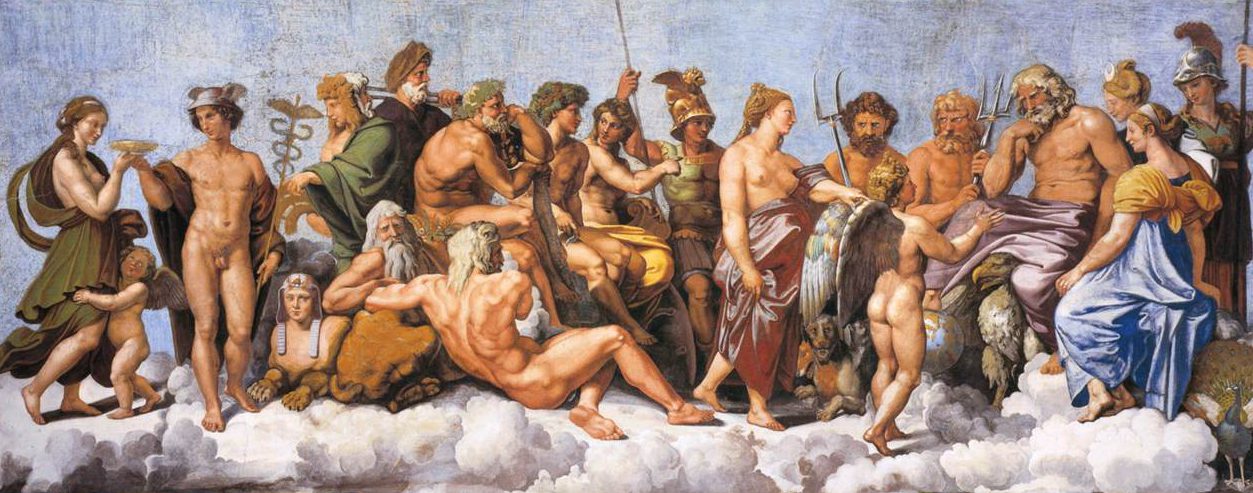Many of the Roman gods and goddesses were derived from the Ancient Greeks Gods.
- Jupiter – The God of Sky and Thunder (Equivalent of Greek Zeus)
- Juno – The Queen of Gods (Equivalent of Greek Hera)
- Neptune – The God of Seas (Equivalent of Greek Poseidon)
- Minerva – The Goddess of Wisdom and Arts (Equivalent of Greek Athena)
- Mars – The God of War (Equivalent of Greek Ares)
- Venus – The Goddess of Beauty and Love (Equivalent of Greek Aphrodite)
- Apollo – The God of Light and Prophecy (Similar to Greek Apollo)
- Diana – The Goddess of Hunt and The Moon (Equivalent of Greek Artemis)
- Pluto – God of the underworld
- Mercury – The God of Wealth (Equivalent of Greek Hermes)
- Saturn – The God of Time (Equivalent of Greek Kronos)
- Ceres – The Goddess of Agriculture (Equivalent of Greek Demeter)
- Bacchus – The God of Wine and Revelry (Equivalent of Greek Dionysus)
- Minor Roman Gods
Jupiter – The God of Sky and Thunder (Equivalent of Greek Zeus)
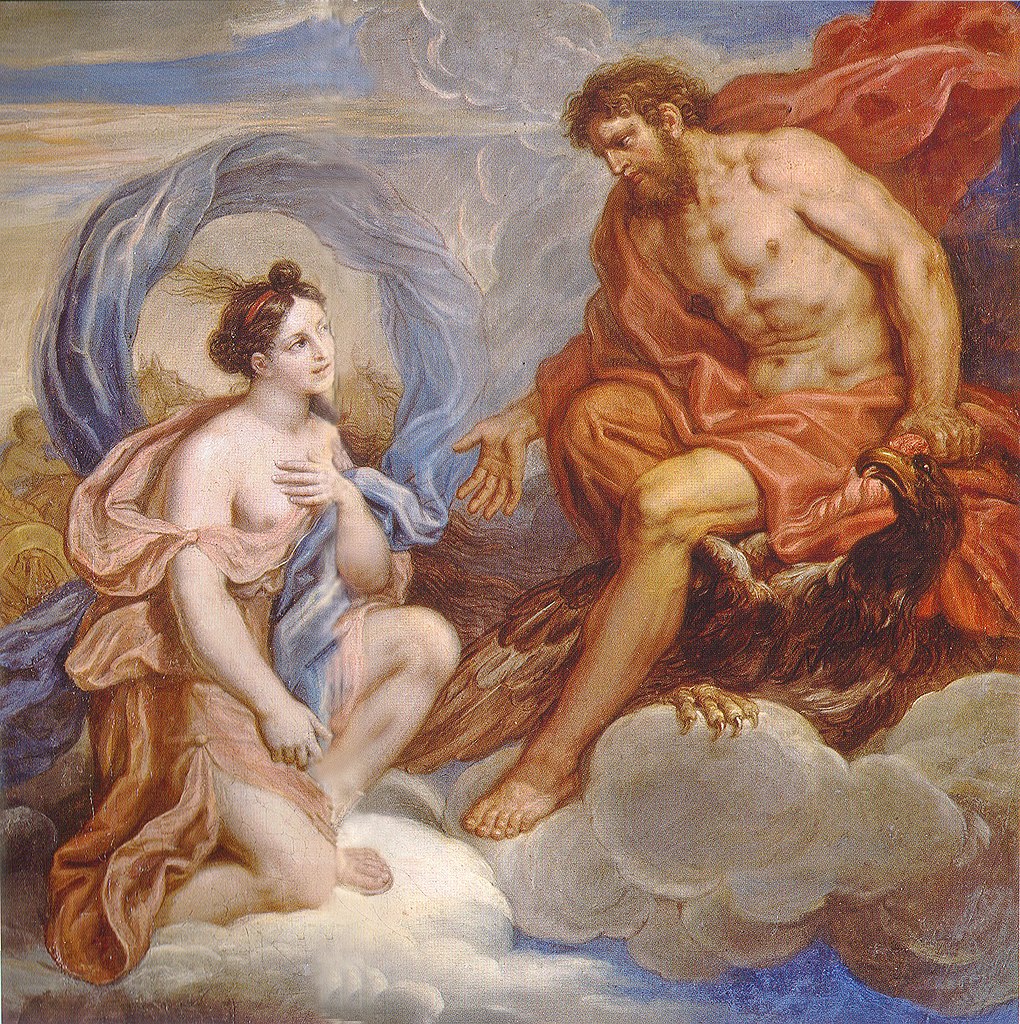
Jupiter was regarded as the Roman equivalent of the Greek God – Zeus. Jupiter was the brother of Neptune and Pluto. He was the king of the gods, also known as the sky god, or the great protector. He controlled the weather and the forces of nature, and he was known to send thunderbolts to warn the citizens of Rome.
The high status enjoyed by Jupiter, often perceived as the equivalent of Greek Zeus, was mirrored by the impressive Temple of Jupiter erected on the Capitoline Hill (possibly by circa 509 BC). To that end, Roman warlords and later generals led their triumphal processions to the temple after securing noteworthy victories, thus outlining Jupiter’s personification as one of the major Roman gods of violence and courage.
Juno – The Queen of Gods (Equivalent of Greek Hera)
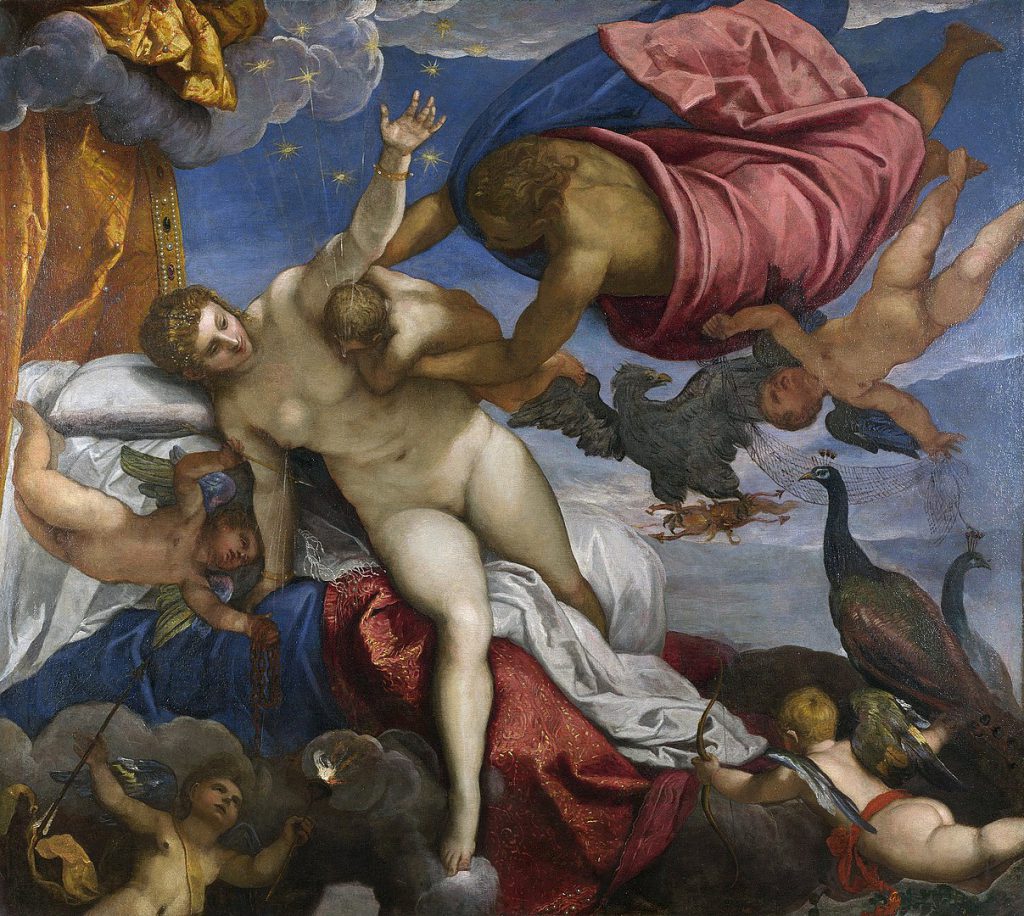
Juno, who was based on the Greek goddess, Hera, was Jupiter’s wife. Juno was the chief goddess on Olympus. It is said that she was the Queen of the Heavens, and was given the title of Regina. She also represented childbirth and fertility. The month of June is named after Juno. She was the daughter of Saturn and the mother of various other Roman gods like Mars, Vulcan, and Juventas.
She was also considered as an esteemed member of the Capitoline Triad (Juno Capitolina) that replaced the earlier so-named Archaic Triad, and her place of worship was possibly centered on the Quirinal Hill in Rome.
She was the patron of fidelity in marriage, although the wife of an erring husband. In Jupiter’s numerous adulterous relationships Juno is often to be seen spying on him while he makes strenuous efforts to escape her. In Tintoretto’s ‘The Origin of the Milky Way’ (above) Jupiter has put his infant son, Hercules, the offspring of the mortal woman Alcmene, to Juno’s breast in order to make the child immortal.
Neptune – The God of Seas (Equivalent of Greek Poseidon)
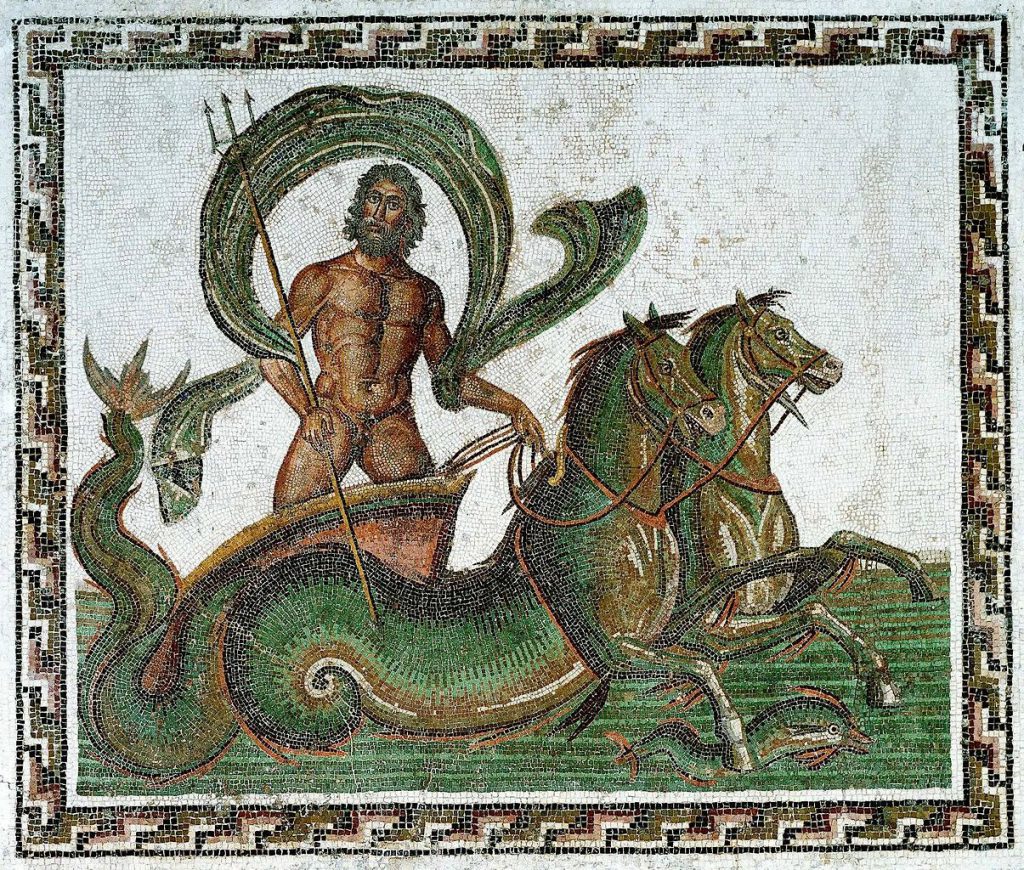
Neptune (Neptunus in Latin) is the Roman equivalent to Poseidon. He was the deity of the sea, although later he was associated with rivers as well. In art, he is often shown with a trident and a dolphin.
Minerva – The Goddess of Wisdom and Arts (Equivalent of Greek Athena)
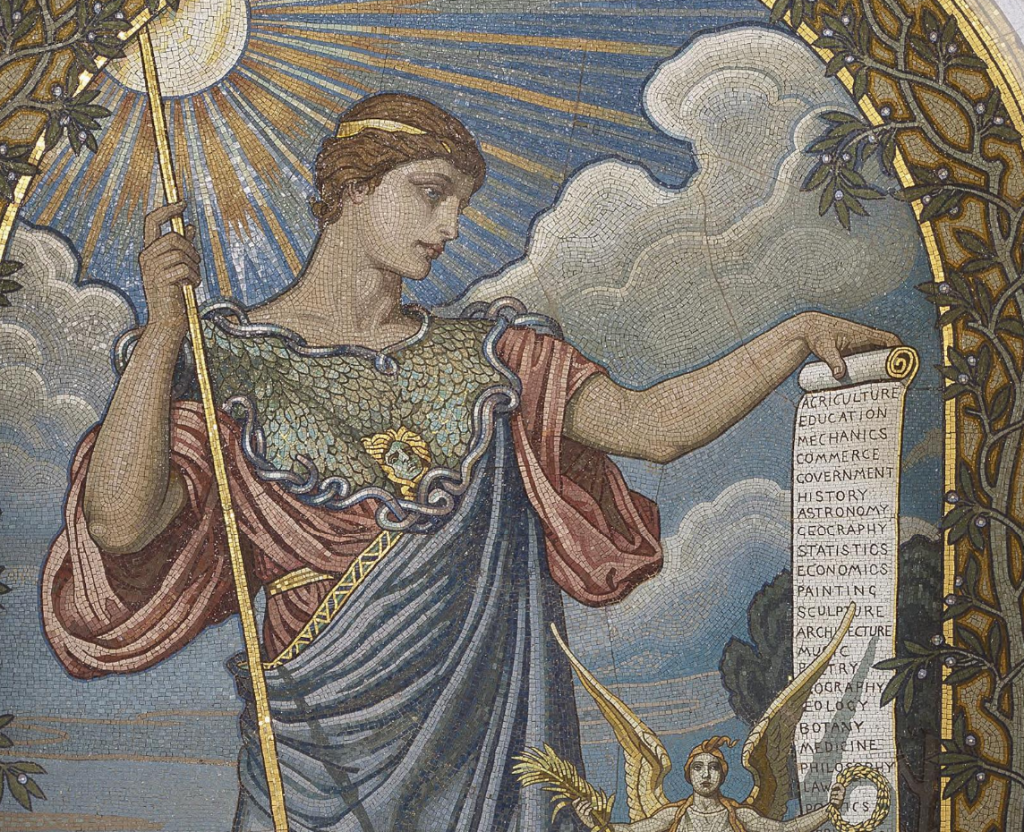
Minerva (Pallas Athena in Greek) was one of the most important of the ancient Greek and Roman goddesses. She was originally a goddess of war, hence her armour and spear. She fought on behalf of just causes and is therefore seen as a civilising influence, in contrast to Mars. By being associated with wisdom she became the patron of a number of institutions of learning and the arts. She was also patroness of many household crafts, such as spinning. The city of Athens was under her special protection.
As an exemplar of wisdom her attributes are books and an owl. Other diverse attributes are also associated with her such as the head of the Medusa which was given to her by Perseus after she had helped him kill the monster. She was one of the three goddesses involved in the Judgement of Paris.
Mars – The God of War (Equivalent of Greek Ares)
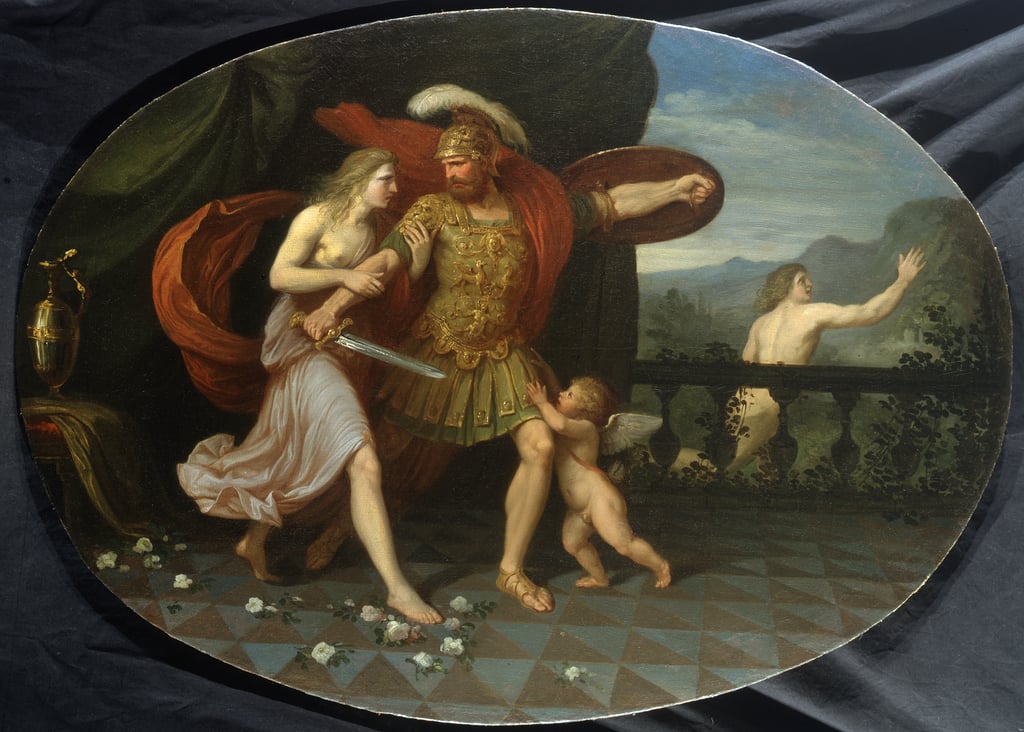
Mars was the Roman version of Ares. He was the Greek god of war, and second in command to Jupiter. He is usually characterised as a youthful and aggressive warrior. He was disliked by most of the gods, with the exception of Venus, who fell in love with him. His attributes are usually a spear, a sword and sometimes a halberd. Mars was considered to be the father of Romulus and Remus, the mythical twin creators of Rome.
His fearsome nature is represented by Rubens in ‘Peace and War’, but his weapons of war lie abandoned while he dallies with Venus, as in Botticelli’s ‘Venus and Mars’ and Palma Giovane’s ‘Mars and Venus’.
Venus – The Goddess of Beauty and Love (Equivalent of Greek Aphrodite)
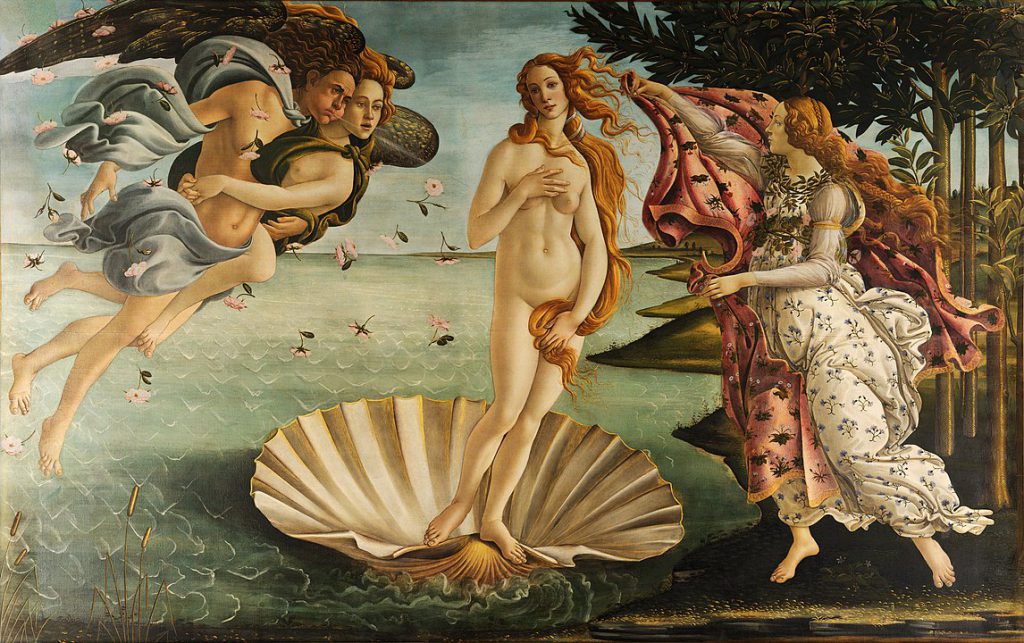
Venus is based on the Greek Goddess Aphrodite, and is the of goddess of love, beauty, and fertility. Venus was mother of Cupid, who is often included in paintings of Venus. According to legend, Venus was born out of the foam of the sea. That’s why in art she is often depicted rising out of the waves in a clam. She is also seen together with the doves which are her attribute. Another attribute is the red rose, which became red because it was stained with Venus’ blood when she stepped on a thorn. According to Hesiod (‘Theogony’), Venus was born from the foam of the sea and carried to land on a scallop shell, as in Botticelli’s ‘Birth of Venus’ in the Uffizi, Florence.
Apollo – The God of Light and Prophecy (Similar to Greek Apollo)
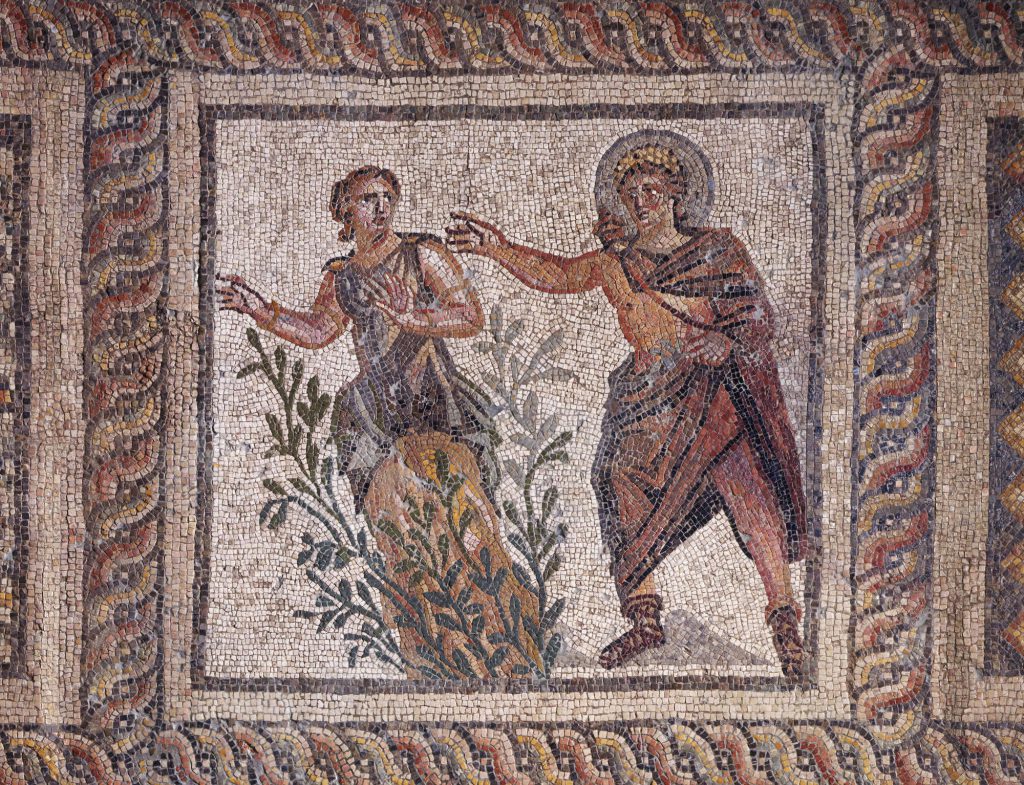
Apollo kept his Greek name and is known as Phoebus in Roman literature, too. Apollo was the son of Zeus and Leto, who, with his twin sister, Artemis, was born on Delos, the island sacred to him. He presided over the Oracle of Delphi, and is associated with prophecy. He sometimes appears in a blaze of light and is a symbol of the sun and an ideal of male beauty.
Apollo had many jobs and responsibilities, as he was the god of archery, music, dance, healing and disease, as well as sun and light. He was seen as one of the most influential Roman gods, and was the son of Jupiter/Zeus.
He is also associated with the arts and sometimes shown with the Muses on Mount Parnassus (for example in Raphael’s fresco, ‘Parnassus’, in the Vatican, Rome).
Episodes from his life are found in Ovid’s ‘Metamorphoses’, some of which are illustrated in the series of frescoes by Domenichino.
Diana – The Goddess of Hunt and The Moon (Equivalent of Greek Artemis)
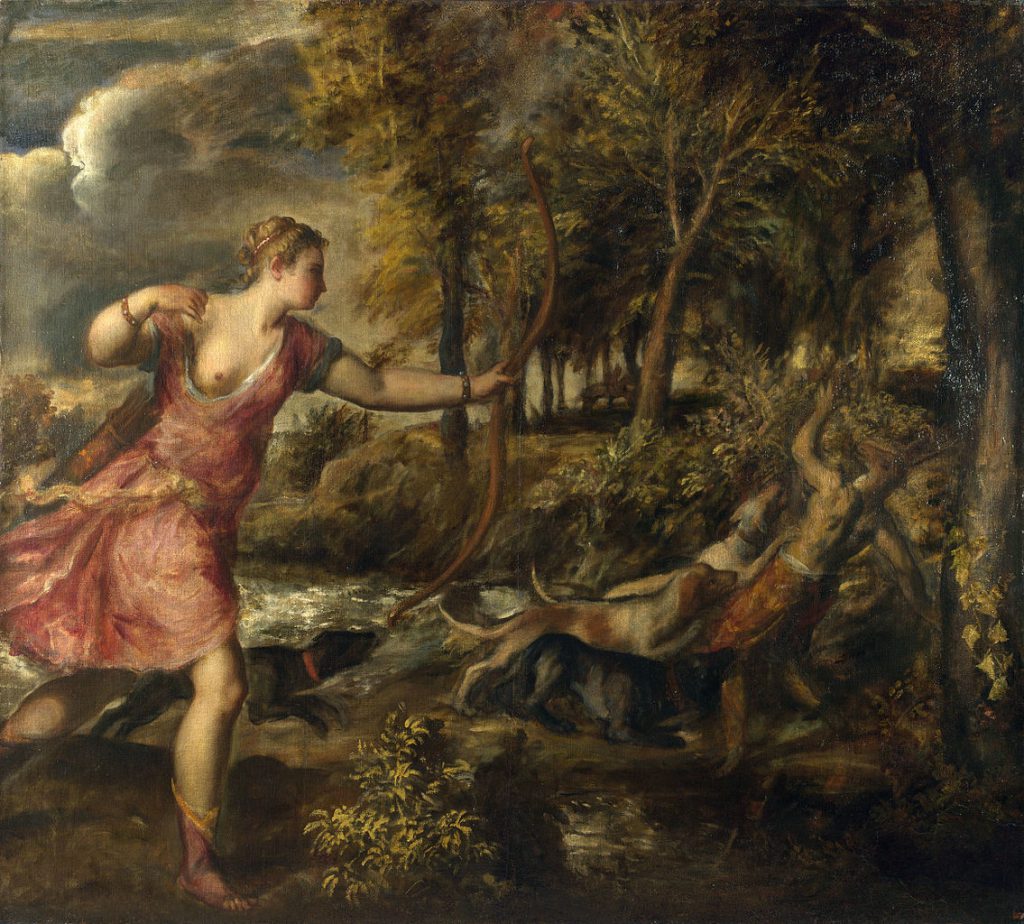
The goddess Diana (in Greek, Artemis) is most often referred to and represented as a chaste huntress.
She was associated with the goddess of the moon, Luna, and as a result is often depicted wearing a crescent moon. Her other attributes include a bow, quiver, spear, dogs and a stag, as well as a shield and a chariot.
She was the daughter of Jupiter and Latona and twin sister of Apollo.
In the above painting Actaeon disturbs the goddess Diana and her nymphs at a secret bathing place. Diana turns him into a stag and he is torn to death by his own hounds.
Pluto – God of the underworld
Pluto was the brother of Jupiter and Neptune, and god of the Underworld. The Underworld was believed by the Romans to be the place people went after death.
Mercury – The God of Wealth (Equivalent of Greek Hermes)
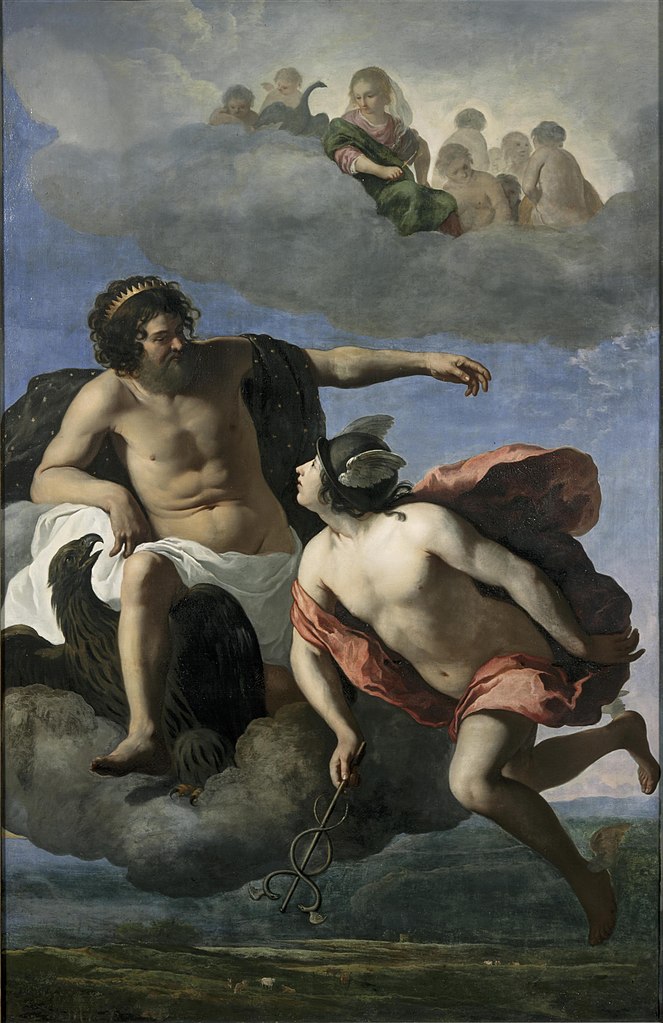
Mercury was the messenger of the gods on Mount Olympus. He can be recognised by his dress: he wears winged sandals, a winged hat, and carries a caduceus, a winged wand with two snakes entwined round it.
He was the god of translation, interpretation and messenger of the gods. He also ruled over wealth, good fortune and commerce.
It was Mercury who brought Paris to judge the beauty of the three goddesses, and who handed Venus the golden apple of discord when she was judged to be the winner.
On account of his swift movement, the volatile metal mercury is named after him.
Saturn – The God of Time (Equivalent of Greek Kronos)
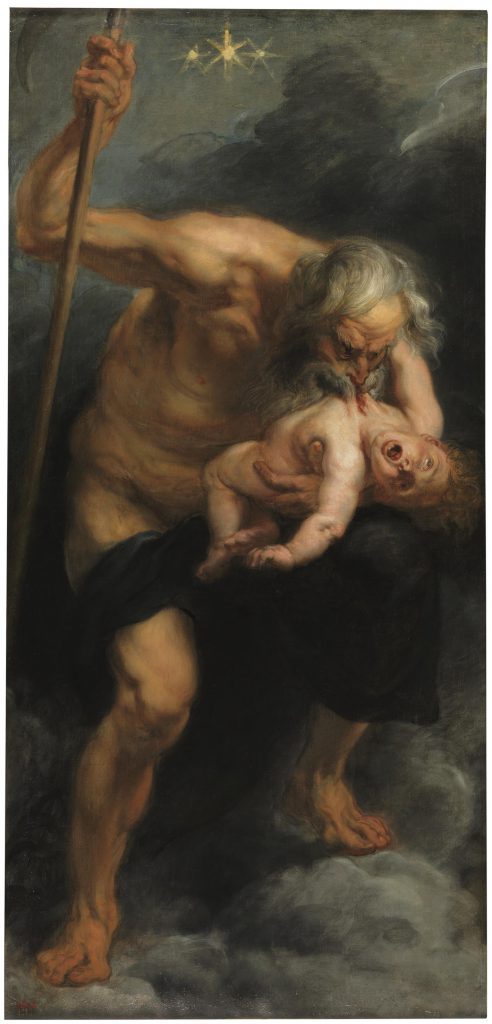
Saturn (Saturnus in Latin) was the first king of the gods, and he was also known as the god of time. Saturn carries a scythe – a tool used to cut crops. Saturn’s festival, the Saturnalia, became one of the most popular Roman festivals. When Saturn died, the world was split between his sons, Neptune, Pluto and Jupiter.
Ceres – The Goddess of Agriculture (Equivalent of Greek Demeter)
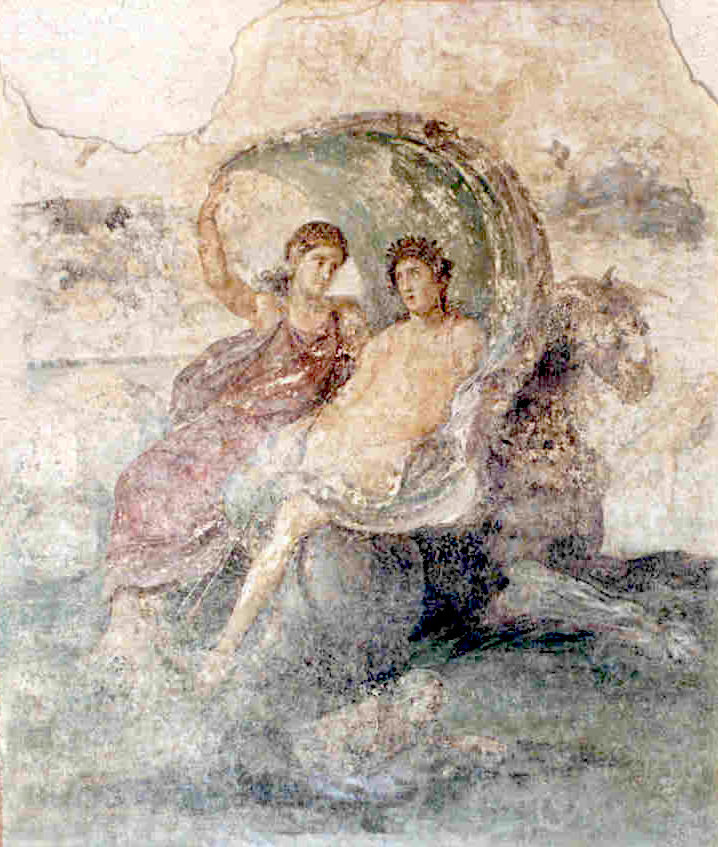
Ceres was the Roman equivalent to the Greek goddess Demeter. In both Greece and Rome she was the goddess of grain and agriculture, so she was extremely important to farmers, and was credited with teaching humans how to grow, preserve, and prepare grain and corn, as she was thought to be responsible for the fertility of the land. Unlike a lot of the gods, Ceres was believed to take an active role in day-to-day life. She was also heavily associated with motherhood and motherly love, due to her close relationship with her daughter Proserpine (or Persephone); the wife of Hades. The Romans believed that the seasons were caused because Ceres went into mourning for half the year when Proserpine was in the underworld with her husband during the winter months, and would celebrate her return by making the earth fertile during the summer.
Bacchus – The God of Wine and Revelry (Equivalent of Greek Dionysus)
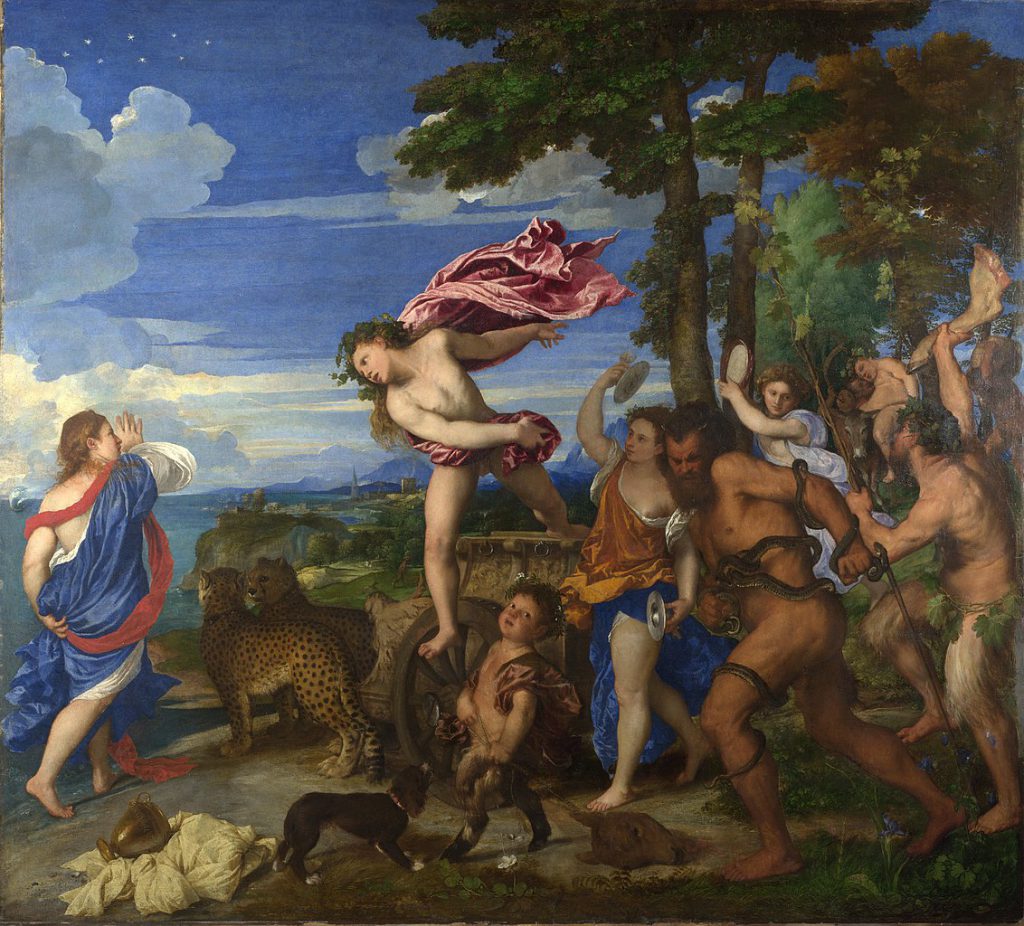
Bacchus was the ancient Greco-Roman god of wine and festivity. His cult was introduced to Rome circa 400 BC and was closely modelled on that of Dionysos. The object of a secret cult whose rites, the Bacchanalia, were infamous for their sexual license and criminal behaviour. Bacchus was also known as Liber (although the latter was sometimes regarded as a separate entity), and under this name was honoured in the festival of the Liberalia.
He was accompanied by satyrs (representing lust) and maenads (dancing girls or nymphs). He was taught by Silenus, who is often shown in Bacchus’ entourage as old, fat and riding on a donkey. Bacchus is sometimes shown in a chariot pulled by leopards. His consort was the princess Ariadne.
Bacchus and his followers are associated with orgies, hence ‘Bacchanals’ are pictures showing satyrs and nymphs carousing and cavorting.
Minor Roman Gods
A – Minor Roman Gods
- Abeona Roman protective goddess of children. Associated with the goddess Adeona
- Abundantia Roman goddess of abundance, prosperity and good fortune. She was commonly portrayed with a horn of plenty, distributing grain and money. After the end of the Roman occupation, she continued inFrench folklore as Lady Habonde (Abundia)
- Abonius Goddess of the hot springs of Abonia
- Acca Larentia, Acca Larentina, Acca Laurentia Roman goddess whose gift of land to the early Romans in the days of Romulus and Remus (according to one account) was celebrated in the festival of Larentalia (or Larentinalia) on December 23. She is variously given as the wife of Faustulus or of Carutius, and as the mother of the Lares, the Fratres Arvales, Hercules, or as the nurse and adopted mother of Romulus
- Acis Sicilian river-god, the son of Faunus and the Nymph Symaethis.Became a river after being bested by the Cyclops Polyphemus in a competition for the hand of Galatea
- Adeona Roman goddess of passage. Associated with the goddess Abeona
- Aeneas The Roman emperor claimed descent from this deified Greek/Roman hero of the Trojan War and an epic voyage to Rome
- Aeolus Roman version of the Greek god of the winds, Aeolos (qv)
- Aequitas Roman god of fair dealing
- Aera Cura Roman goddess of the infernal regions
- Aesculapius Roman form of the Greek Asklepios, god of healing and medicinal arts, his cult was introduced to Rome during the plague of 293 BC. In Rome he took the form of a snake, and a staff with snakes entwined around it became his attribute
- Aeternitas Roman personification of eternity. Symbolized by the phoenix rising from its own ashes and by the Uroboros (a snake biting its own tail)
- Aius Locutius Roman nonce-god reported to have foretold the invasion of the Gauls in 391 BC
- Alemona Roman goddess of passage
- Alpan, Alpanu, Alpnu Etruscan goddess, one of the demons called Lasas. The evidence suggests she may have originally have been a goddess of love and of the underworld
- Amor Roman god of love, equivalent to the Greek Eros. He was the son of Venus and either Mars or Mercury
- Angerona, Agenoria Roman goddess of secrecy and industry, and winter silence and suffering in general. Her festival was 21 December, the winter solstice
- Ani Etruscan sky-god or god of heaven. Sometimes equated with the Roman Janus
- Anna Perenna Roman goddess of the circle of the year. She was worshipped in a grove to the north of Rome. Her festival was celebrated on the full moon of the first month of the Roman year (our March 15: the Ides of March). It is at that festival where a person drinks as many cups of wine as the years they wish to live
- Antevorta Roman goddess of the future
- Appiades Five Roman gods occupying a temple by the Appian aqueduct: Venus, Pallas, Concord, Peace and Vesta
- Aplu Etruscan god of thunder and lightning, modelled on the Greek Apollo. Usually depicted with a wreath of laurel on his head and with a staff and a laurel twig in his hands
- Aquilo Roman weather god, associated with the north wind (the Greek Boreas)
- Arachne Roman god of weaving
- Aritimi The Etruscan equivalent of the Greek goddess Artemis
- Atunis Etruscan form of the greek Adonis
- Aurora Roman goddess of the dawn, equivalent to the Greek goddess Eos
- Auster The Roman name for the southwest wind, equivalent to the Greek Notus
- Agenor God of action, like a force or impulse, as in Star Wars
- Aesculanus The god who assisted Pecunia in production and protection of metal coins
- Angitia She was sister of CIrce and Medea. She healed people who had ingested poison. There was a groved sacred to her on Lake Fuscinus which had snakes and herbal medicines
- Anteros God which developed mutual love and tenderness between married partners
- Albunea Verro says she is one of the sibyls, the prophets priests. Her name means white, and was said to be an inhabitant of sulpher streams like the spring near Tibur in Ital
B – Minor Roman Gods
- Bona Dea (The Good Goddess) Roman fertility goddess, otherwise known as Fauna (qv). Her festival was 4 December, when secret rites were held to which only women were admitted. Her consort was Faunus
- Bonus Eventus Roman god of success(luck) in one off enterprises
- Bubona Roman goddess of horses and cattle. She was the counterpart of the Celtic goddess Epona.
- Bellona, Duellona Roman goddess of war, given variously as the wife or sister of the war god Mars. Her festival was June 3 with races between men and boys. She is variously described as tall with a head covered with snakes instead of hair, she carried a whip, but started war by throwing a spear into the enemies territory. Her temple had no door. Her priests mutilated themselves to offer her blood. They were weird.
- Bibesia God of beverages at a meal
C- Minor Roman Gods
- Caca Roman goddess of the hearth, in which capacity she was later succeeded by Vesta. She was the daughter of Vulcan and Medusa, and the sister of Cacus
- Cacus Originated as a pre-Roman god of fire who later became a fire-breathing demon. He was said to live in a cave on the Palatine hill in Rome. It was Cacus who stole the cattle of Geryon, and he was killed by Hercules whose labours included the recovery of the cattle of Geryon
- Camenae, Kamenae Roman oracular goddesses, patrons of the sacred spring that supplied water for the Vestal Virgins. They were identified with the Greek muses
- Candelifera Roman goddess of birth, associated with the goddesses Lucina and Carmentes
- Cardea Roman goddess of thresholds and door-pivots, popularly believed to ward off evil spirits. She was associated with the god Janus,although she remained a virgin goddess
- Carmenta Roman goddess of fate or fortune, one of the Camenae (qv). Also a goddess of childbirth, associated with Lucina and Candelifera. Her Greek equivalent was Themis
- Carna(Flesh) Roman goddess of bodily organs, particularly of hearts. Her festival was held on June 1. She was associated with Janus as the protector of the outside of houses. The story was that Janus raped her then in remose made her a goddess.
- Castur and Pultuce Etruscan version of the Greek Dioskuroi
- Ceres Roman corn goddess identified with the Greek Demeter. She is the daughter of Cronus and Rhea, and is one of the consorts of Jupiter. Like Demeter, Ceres belongs to the long line of ‘great mother’ goddesses dating back to the Sumerian Inana and the Babylonian Ishtar. She had a daughter by Jupiter, Proserpina, who was abducted by the underworld god Pluto in a myth which parallels that of Demeter and Persephone. Proserpina spends half the year (winter) in the underworld with Pluto, during which Ceres neglects her duties and plant-life languishes. However, each spring Proserpina is restored to Ceres and plant life flourishes once more. Ceres’ festival was the Cerealia, celebrated on April 19
- Ceres Africana, Ceres Punica North African goddess of the harvest mentioned by the Christian apologist Tertullian
- Charites, Greek Gratiae Roman name for the Graces. Their numbers varied, although a basic trinity is commonly recognized: Aglaia (splendour), Euphrosine (cheerfulness or festivity), and Thaleia (rejoicing or blossom). The Greeks knew them under the collective name of the Gratiae (qv).They were the attendants of Aphrodite or Venus, and personified grace and beauty
- Chnubis Roman syncretic god with Greek and Egyptian associations, portrayed as a snake with a lion\’s head
- Cinxia Roman goddess of marriage.Her official capacity was loosening the girdle of the woman which indicated she was no longer a girl, but a matronn and likely to become pregnant
- Clementia Roman goddess of mercy and clemency
- Clitunno, Clitumnus He was a prophetic river god in the province of Umbria whose river waters was said to heal illnesses of all sorts
- Cloacina Roman goddess of sewers
- Collatina Goddess of landscaping of hills and dales
- Concordia Roman goddess of harmony and peace
- Condatis River god of Celtic Britain
- Consentes Dii The twelve chief Roman deities: Jupiter, Apollo, Neptune, Mars,Mercury, Vulcan, Juno,Diana, Minerva, Venus, Ceres and Vesta
- Consus Roman god of good counsel. His feast days were August 21 and December 15
- Copia(Abundance) The Roman goddess of wealth and plenty. She was the handmaiden of Fortuna and carried the cornucopia
- Corus Roman wind god representing the north-west wind
- Cunina Roman goddess of infants
- Cupid Roman god of love, identified with the Greek Eros. Son of Venus and Mars, or Venus and Mercury, or Diana and Mercury. Also Amor
- Cautha, Cath Etruscan sun god, generally depicted as rising from the sea
- Charontes Etruscan demons of death. The name is derived from the Greek Charon
- Charun Etruscan demon of the underworld, similar to the Greek Charon
- Culsu Etruscan demoness who guards the entrance to the underworld
- Caia Caecilia The deified mortal Princess Tanaquilm represented healing
- Cleurca, Carda She was originally a river nymph and virgin hunter. Any man who tried to seduce her she would lead to a cave and ask him to enter it first. When he went in she would run off into the forest. She did this to Janus who saw her running off since he had faces pointing backwards and forwards both
- Camoena The goddess of singing. She was portrayed as an old crone. Ovid tells of her being a go between Mars and Nerio when Mars was wooing Nerio
- Comus God who represented the pleasures of night life
D – Minor Roman Gods
- Deverra Roman goddess of birth
- Dea, Dia Ancient Roman goddess of the fields, honoured with three feast days in May, especially wheat
- Decima Roman goddess of childbirth. Later Decima, with the goddesses Nona and Morta, formed the Parcae, the Roman goddesses of fate
- Dei Consentes Roman council of 12 gods
- Diana Roman moon goddess and goddess of woodlands. She was also regardedas a goddess of fertility and childbirth. Daughter of Jupiter and Latona. Equivalent to the Greek Artemis. She had a sanctuary on the Aventine Hill in Rome
- Discordia, Discord Roman goddess of strife. Equivalent to the Greek goddess Eris
- Dis Pater, Dis Roman ruler of the underworld. Also known as Plutos which is Greek for wealth and was an alternative (and likely older) name for the Greek ruler of the underworld Hades. Dis Pater was husband of Persephone. Virgil’s Book 6 of the Aenid has the details
- Dius Fidius Sabine sky god of ancient Italy. Worshipped by the Romans as a god of oaths
- Domitius, Domidius God who helped the groom get the bride over the threshold and into the marrige house. He was tall, dark and handsome. And very strong
E- Minor Roman Gods
- Edesia Goddess of food preparation
- Educa Goddess who ensured baby food was safe
- Egeria Roman water spirit, goddess of fountains and protectress of unborn children. Said to have been the second wife of Numa Pompilius, the second king of Rome.She was a Carmena
- Evander, Evandrus Minor Roman god, who greeted Aeneas at the future site of Rome. He was said to have introduced the Greek pantheon and alphabet to Rome
F- Minor Roman Gods
- Fabulinus Roman god of infants. According to Varro, it was Fabulinus who taught children to speak their first word
- Falacer A deified Roman hero, he was worshipped in temples by the 15 priests called the Flamenes. Nothing else is known
- Fama Roman personification of popular rumour. Also a goddess of fame. Her Greek counterpart was Pheme. She was largely a literary conceit rather than a true goddess of Roman religion
- Fates, Latin Fata or Parcae Hesiod gives the Greek Moirae as Atropos, Clotho and Lachesis. Their Roman counterparts were Decima, Nona (goddesses of birth) and Morta (goddess of death)
- Fauna, Fatua, Bona Dea, Bona Mater Roman goddess of nature and fertility, and childbirth. Her husband was Faunus. Her festival was on December 4
- Faunus, Faustitas Roman god of crops, herds and fertility. An oracular deity as well as a woodland deity. He was the son of Picus and the husband of Fauna. The Romans regarded him as a counterpart of the Greek Pan
- Favonus The Roman god of the west wind. Equivalent to the Greek Zephyros
- Febris Roman goddess of fever
- Fecunditas Roman personification of fertility
- Felicitas Roman goddess of good luck and happiness
- Feronia Roman goddess of orchards and woodland, tames wild things, and frees slaves
- Fides Roman god of good faith, honesty and oaths. Her festival day was October 1
- Flora Roman goddess of fruitfulness and flowers. Her husband was Favonus (Zephyrus), the god of the west wind. Her festival was the Floralia, noted for its sexual license, observed from April 28 to May 1
- Fontus Roman god of springs. Son of Janus and Juturna. His festival was observed on October 13
- Fornax Roman goddess of bread-making. Her festival was observed on February 17
- Fortuna, Fors Fortuna Roman goddess of fate and chance, earlier of prosperity. She was an equivalent of the Greek goddess Tyche. Her symbol was the wheel of fortune. Other attributes include a globe, rudder and a cornucopia. Her festival was observed on June 24
- Fraus Roman goddess; the personification of treachery
- Fulgora Roman goddess of lightning. Summanus was borrowed from the Estrucans to represent nighttime thunderstorms
- Furies, Latin Furiae Roman goddesses of vengeance, equivalent to the Greek Erinyes
- Furina Roman goddess of thieves
- Februus Etruscan underworld god and more generally an Italian god of purification. He gave his name to February, which was his sacred month
- Feronia Etruscan fertility goddess representing sexual fire
- Fufluns Etruscan god of gaiety and vitality
- Fons Goddess of urban springs. She had a festival in October when the springs started to flow again after the summer drought, the Fontinalia
- Frutesca God of abundance of fruit, a bountiful harvest from the fruit groves
- Fessonia Goddess who helps and succors those weary in body and soul
- Fascinus The god protects people from envy, evil, black magic, illness and demons. One god does it all
- Forculus He was a rarely mentioned household god who was responsibility for the integrity of thresholds. The step which changed from outside to inside or visa versa was considered very very important to the Romans. This responsibility was incorporated into the many different forms of changes that Janus represented
G- Minor Roman Gods
- Genius Roman protective god or spirit of individuals, clans, groups and the state
- Genius Loci Roman tutelary spirit of a particular place
- Gold Branch Norse seeress of Vanir
- Genii Etruscan/Roman protective spirits
- Gratiae Roman graces
- Genita-Mana Latin meaning: Life and Death, God with the power over life and death
H- Minor Roman Gods
- Hercules Roman form of the Greek Herakles. To the Romans, Hercules was a god of merchants and traders
- Hippona Roman goddess of horses
- Honos Roman deified abstraction of honour
- Horta Etruscan goddess of agriculture
- Hora Goddess who attended Venus, she represented beauty personfied
- Hersilias Deified by Juno she was the wife of Romulus who after his deification is called Quirinius. She does not appear to have any writing about what he functions were if anything
I- Minor Roman Gods
- Indigetes Dii Roman name for deified mortal heroes, such as Aeneas, Heracles and Romulus
- Inuus Old Latin god of herds
J – Minor Roman Gods
- Jana Minor Roman goddess. Consort of Janus
- Janus Roman god of passage, of doorways (januae), archways (jani), and ofbeginnings and endings. Also a god of the threshold between the old year and the new, in token of which he gave his name to the month of January. His jurisdiction included gates, harbours, travel, daybreak — things which had the sense of beginning or going out. Janus was said to be the son of Apollo and Creusa, although he had no Greek equivalent. His consort was Jana. He was the father of Tiberinus by Camasena, of Fontus by Juturna, and of Canens by Venilia. Janus was depicted either as two-faced (Bifrons) or four-faced (Quadrifons). His attributes included keys and a staff. The doors of his temple in Rome were kept locked in peacetime and thrown open in wartime. His festival was the Agonium, which was held on January 9. The beginning of the day, month, season and year were sacred to him
- Jove An alternative name for the Roman god Jupiter
- Juno, Iuno The chief Roman goddess, equivalent to the Greek goddess Hera. In general she was the goddess of women, particularly associated with the institution of marriage. Juno was also the female counterpart of the male Genius: just as each man had his individual genius, so every woman had her individual juno. She was also known as Juno Lucina in her capacity as goddess of childbirth, Juno Moneta in her capacity as goddess of finance, and Juno Regina in her capacity as protectress of the Roman Empire. She was the daughter of Saturn and Rhea, and the sister and consort of Jupiter. Mother of Mars, Vulcan and Juventas. The month of June was named after her. Juno was honoured with two festivals: the Matronalia on March 1 and the Nonae Caprotinae (“The Nones of the Wild Fig”) on July 7
- Juno Caelestis Tutelary goddess of Roman Carthage
- Jupiter, Iuppiter, Juppiter, Jove, Diespiter Chief Roman god, originally a sky god and a god of light. He was later equated with the Greek Zeus, although the origins of both have been traced back to a hypothetical Indo-European sky god, indicating that the similarity in their roles was not entirely due to Roman copying of a Greek original. Jupiter was also a god of thunder (Jupiter Tonans) and lightning (Jupiter Fulgurator). With the military expansion of Rome, Jupiter took on appropriate characteristics as Jupiter Victor and Jupiter Stator (\”Jupiter Protector\”). Jupiter was also important as a god of oaths, contracts and treaties. His consort was Juno. Jupiter\’s main sanctuary was the temple of Jupiter Optimus Maximus (\”Jupiter, Best and Greatest\”) on the Capitoline Hill in Rome, which was originally constructed by the Etruscans before they were overcome by the nascent Roman Republic. On the Capitol, heformed a trinity with Juno and Minerva. The Ides of each month (13 or 15) and the full moon were sacred to him. He was also worshipped at the festival of the Vinalia on August 19, which he shared with Venus
- Jupiter Ammon Syncretic Egypto-Roman deity
- Justitia, Iustitia Roman goddess of justice
- Juturna, Iuturna Roman goddess of wells and springs. She was the mother of Fontusby Janus. Her festival was held on January 11 (the Carmentalia)
- Juventas, Iuventas Roman goddess of youth, particularly young men of military age. Her Greek equivalent was Hebe
- Jugatinus God of mountain reidges and marriages, which both start with the letter M. Otherwise there is no connection
- Juga Goddess of courtship for marriage, a type of divine chaperone and well wisher for the couple
K – Minor Roman Gods
- Kamenae, Camenae Italic goddesses of springs and wells
L – Minor Roman Gods
- Lactans, Lactanus Roman god of agriculture. Said to make the crops \’yield milk\’,i.e. thrive
- Lacturna Goddess of growing wheat
- Lar Roman god of the house. See Lares
- Lares, Singular: Lar Roman tutelary deities, particularly of households (Lares Familiaris). They were said to be the children of Mercury and the naiad Lara
- Lares Compitales Roman guardian deities of crossroads. Their festival was held on January 5
- Lares Familiaris Roman tutelary deities of the home and the family, particularly associated with the hearth. Each home had a small shrine, the lararium, dedicated to these deities, typically depicted as a pair of dancing youths
- Lares Viales Roman tutelary deities of travellers
- Larunda Sabine earth goddess
- Larvae Roman spirits. See Lemures
- Latona, Leto Roman counterpart of the Greek Leto (qv)
- Lasas Etruscan female deities
- Lemures, Larvae Roman malignant spirits or ghosts of the dead, believed to wander about at night
- Liberalitas Roman god of generosity
- Liber Old Italic fertility god. Originally associated with animal husbandry and the cultivation of crops, he was later equated with the Greek Dionysos. He was part of a chthonic triad including Libertas and Ceres. His festival, shared with his consort Libera (a.k.a. Libertas), was the Liberalia, celebrated on March 17.
- Liber Pater Roman god of human and agricultural fertility, linked with Dionysus
- Libertas Roman goddess of freedom and constitutional government. Her attributes included the pileus (the cap worn by freed slaves) and a sceptre or lance. Her principal sanctuary was a temple on the Aventine Hill in Rome
- Libertas, Libera Roman goddess of freedom and constitutional government. Her attributes included the pileus (the cap worn by freed slaves) and a sceptre or lance. Her principal sanctuary was a temple on the Aventine Hill in Rome
- Libitina Roman goddess of death and funerals
- Lucifer Roman name for the morning star. Equivalent to the Greek Eosphoros. Christian name for Satan
- Lucina Roman goddess of childbirth
- Luna(Moon) Roman goddess of the moon. Equated with the Greek Selene and, to some extent, Hekate. Her principal sanctuary was a temple on the Aventine Hill in Rome. Her festival was on March 31
- Lupercus Roman god of flocks and fertility. He was also a god of wolves,presumably in the capacity of a protector of domestic animals against wolves. His festival was the Lupercalia, celebrated on February 15
- Laran Etruscan war-god
- Lasas Etruscan female deities
- Laverna Old Italic underworld goddess. Libations to her were poured out with the left hand. Prayers were made to her for the appearance of honesty
- Liber Old Italic fertility god. Originally associated with animal husbandry and the cultivation of crops, he was later equated with the Greek Dionysos. He was part of a chthonic triad including Libera and Ceres. His festival, shared with his consort Libera,was the Liberalia, celebrated on March 17
- Libera Old Italic fertility goddess. She was later equated with the Greek Persephone. She was part of a chthonic triad with Liber and Ceres. Her festival, shared with her consort Liber, was the Liberalia,celebrated on March 17
- Limentinus One of the very rarely mentioned household gods who was responsible for protecting lintels a staple in Roman cooking
- Lina Goddess of weaving textiles, especially wool. The shearing and carding was the responsibility of other gods
- Lua Goddess wife of Saturn (maybe) and protected things purified by ritual
- Lapis One of the names given to Iupeter. Iupeter Lapis, meaning god of stone, that is where he represented contracts and their immutability
- Libentina Goddess of lust, attended Venus
- Lapis One of the names given to Iupeter. Iupeter Lapis, meaning god of stone, that is where he represented contracts and their immutability
M – Minor Roman Gods
- Maia Roman goddess of fertility, associated with Fauna
- Manes, Di Manes Roman collective name for the spirits of the dead, who inhabited the Underworld. The Manes were honoured in the festival of the Parentalia, from February 13 to February 21. All temples were closed during the festival
- Mania Roman goddess of the dead
- Mania With Mantus, a guardian of the Etruscan underworld
- Mars, Marspiter, Mamers, Marmar, Mavors Roman god of war and, at least in early Roman history, a god of agriculture. Equated with the Greek Ares. Son of Jupiter and Juno. He was the father of Romulus and Remus by the vestal Ilia. As a result, Romans styled themselves \’sons of Mars\’. He was typically depicted as a warrior in full battle regalia wearing a crested helmet and bearing a shield (the sacred Ancile) and lance. He was often linked with the goddess Bellona, who drove his chariot. The main sanctuaries of Mars were the temple in the Campus Martius (\”Field of Mars\”) in Rome and the temple of Mars Ultor (\”Mars the Avenger\”) built under Augustus. The month of March was named after him, and he had a festival on March 1 called the Feriae Marti, which was the New Year\’s Day in the old Roman calendar. Another festival at which Mars was honoured was the Armilustrium on October 19, when military arms were ritually purified and put in storage for winter.In Gaul it was sometimes called Gallicus Mars
- Mater Matuta Old Italic goddess of the dawn. She later developed into a goddess of women and childbirth. Furthermore, in her later equation with the Greek goddess Ino, she came to be regarded as a tutelary goddess of seafarers. Her festival was the Matralia, observed on June 11 the summer solstice then
- Matura Goddess of Flowering Wheat
- Meditrina Roman goddess of healing. Her festival was the Meditrinalia held on October 11
- Mefitis Roman goddess of sulphur springs, stenches in general, particularly those associated with swamps and other areas associated with disease
- Mellonia, Melonia Roman goddess of bees, and honey. Daughter of Mars, she was worshipped by bakers who used honey to make bread
- Mena, Fluonia Roman goddess of menstruation
- Mercury, Mercurius Roman messenger god and god of merchants and travellers. Equated with the Greek Hermes. Son of Jupiter and Maia. He had a temple on the Aventine Hill in Rome, said to date from 495 BC, as well as a shrine in the Circus Maximus. His festival was the Mercuralia,observed on May 15. Mercury is depicted as holding a purse,symbolic of his association with commerce, as well as the winged sandals (talaria), winged cap (petasus) and staff (caduceus) taken over from the Greek Hermes. According to Juvenal, posts topped by marble heads of Mercury were placed at the intersections of Roman roads
- Messor Minor Roman god of agriculture
- Minerva Roman goddess of war, and secondarily a goddess of wisdom and the arts and trades. As Minerva Medica she was regarded as a patroness of physicians. Equated with the Greek Athena, though she may derive originally from the Etruscan Menrva. Daughter of Jupiter. Her main festivals were the Minervalia and Quinquatria (March 19- 23). She shared the main temple on the Capitoline Hill as part of a triad with Jupiter and Juno, and also had a temple on the Aventine Hill in her capacity as Minerva Medica. In Gaul, just the goddess of handicrafts and arts
- Menrva, Menerva Etruscan goddess, equivalent to the Greek Athena, and predecessor of the Roman Minerva. She was part of the Etruscan triad with Tinia and Uni
- Mithras Greco-Roman name of Mithra. Mithras became popular as a god of soldiers in the Roman Empire beginning in the first and second centuries AD. He was regarded as a god of loyalty and truth, and of the struggle aginst evil. The cult of Mithraism excluded women,and its rites were conducted in underground temples known as mithraea (sing. mithraeum). The central rite involved the ritual slaughter of a bull, symbolizing the regeneration of life and the world
- Mors Roman god of death. Equated with the Greek Thanatos
- Morta Roman goddess of death, who later became associated with Decima and Nona as one of the Roman Fates
- Muta Roman goddess of silence
- Mutinus, Mutunus Roman fertility god. Depicted as ithyphallic or as a phallus. He was invoked by women seeking to bear children
- Mamurius The god representing the old year. He was thrown out of the festival on March 15 for Anna Perenna, representing the new year
- Mercia The goddess who personified laziness
- Molea Goddess of grindstones for milling bread also a daughter of Mars, and worshipped by millers
- Manturnea Goddess who kept the couple together throughout marriage until their death
N – Minor Roman Gods
- Necessitas Roman goddess of destiny
- Nethuns Etruscan god of water
- Neptune, Neptunus Roman god of the sea. Neptune was originally a Roman god of fresh waters until he was equated with the Greek Poseidon. He may be derived from the Etruscan god of water, Nethuns. Husband of Salacia. Also a god of horse-racing. His festival, the Neptunalia, was held on July 23, the height of the midsummer drought, probably a reference to Neptune\’s original role as a god of the fresh waters essential to agriculture. Otherwise, Neptune\’s representation in art and literature was essentially identical with that of Poseidon
- Nona Roman goddess of birth. Her name means ninth month, an allusion to the term of pregnancy. She later became associated with the goddesses Decima and Morta as one of the Roman Fates
- Nortia Etruscan goddess of fate and fortune. In an Etruscan New Year rite, a nail was hammered into a block of wood at her temple at Volsini. This rite has been variously interpreted as a fertility rite or as an expiation rite for the year just past
- Naenia God of the dead especially for the aged people
- Nerio Old Sabine goddess, consort or Mars
- Nemestrinus A landscaping god, only mentioned by the ancient author Arbonius
- Neverita Wife of Neptune. She had a very nasty tempter, and when she and Neptune argued hurricanes would result
- Numeria Goddess in charge of numbers, counting, arithmetic and mathematics overall
O – Minor Roman Gods
- Occator Diety responsible for harrowing the soil
- Ops Roman goddess of the harvest. She also governs the proper growth of the seed. Consort of Saturn. Equated with the Greek goddess Rhea. Her festival was the harvest festival of the Opiconsivia,observed on August 25
- Orcus Roman underworld. Equivalent to the Greek Thanatos. It is ruled by Dis Pater equivalent to Greek Plutos in meaning, which is wealth
- Opigena Ancient goddess who helps in the process of a swift and safe childbirth
- Ossipaga Goddess responsible for hardening the bones of infants
- Orbona Goddess who protected orphans
P – Minor Roman Gods
- Paventia Goddess who created Terror in Children
- Palatua Spirit of the Palatine hills representing city civic responsibility
- Pavor God associated with dispelling mental distress and anguish
- Pales Roman goddess of flocks and herds (originally male). Her festival,the Parilia, was celebrated on April 21. The Parilia was said to be the \’birthday of Rome\’, commemorating the day Romulus was said to have drawn the first furrow laying the foundations of the Roma Quadrata, the oldest part of the city of Rome
- Palici Twin Sicilian gods associated with a pair of geysers near Palagonia still known as the Lago dei Palici. Their shrine became a sanctuary for slaves, and as such played a prominent symbolic role in the Sicilian slave revolts of the 2nd century BC. The Palici were later identified as the offspring of either Zeus and Thalia or Hephaestus and Aetna
- Parcae Roman goddesses of fate. Originally they included only the pair of Decima and Nona, both goddesses of birth. Later, under the influence of the Greek Fates, the Moirai, the goddess of death Morta (Parca) was added to form a triad
- Partula Minor Roman goddess of birth, concerned with parturition
- Pallor God associated with panic as Deimos is in Greek mythology
- Panda Goddess of opening roads and towns for the first time
- Pax Roman goddess of peace. Equated with the Greek Eirene. She was first recognized as a goddess proper under Augustus. An altar of Pax Augusta was erected at the Campus Martius (Field of Mars) in 9 BC, and a temple of Pax was completed under Vespasian in AD 75. She was depicted as a young woman bearing a cornucopia, an olive branch and a garland of corn. Her festival was celebrated on January 3
- Penates, Di Penates Roman household gods. Originally they were gods of the storeroom (penus), but their role gradually expanded to include the entire household. They were associated with, but not identical with,other household deities such as Vesta and the Lares. They were represented by small statues gathered together in a household shrine, to which offerings of food were made. The Roman state also had its Penates, the Penates Publici, which were the focus of a state cult
- Perfica Goddess of coitus, she attended Venus
- Picus(Woodpecker) Roman woodland god in the form of a woodpecker. Also an agricultural deity associated with the fertilization of the soil with manure. The woodpecker was sacred to the god Mars, and played an important role in Roman augury. Later Roman writers made Picus an early Italian king, while Virgil made him the son of Saturn and the father of Faunus. In early Roman art, Picus was depicted as a wooden pillar surmounted by a woodpecker. He later came to be represented as a youth with a woodpecker perched on his head
- Pietas Roman goddess personifying respect and fidelity to gods, country and relatives. A sanctuary in Rome was dedicated to Pietas as early as 191 BC
- Pilumnus Ancient Roman god, given variously as a god of agriculture or a guardian deity of infants at birth
- Pluto Roman god of the Underworld. Derived from the Greek Hades,and largely indistinguishable from him. However, in Roman tradition the entrance to hell was said to be at Avernus in Rome
- Poena Roman goddess of punishment
- Pomona Roman goddess of fruit trees. After spurning the advances of many suitors, she eventually became the wife of the god Vertumnus,although some sources make her the wife of Picus
- Portunus, Portumnus Roman god of gates, doors and harbours. In other words, a god associated with the entrance to both the city and the home. As a god of ports, he came to be equated with the Greek Melicertes. His festival, the Portunalia, was celebrated on Auguts 17. At his festival, keys were thrown into the fire in order to bless them. He was depicted as a youth bearing keys
- Porus Roman god of plenty
- Postverta, Postvorta Roman goddess of the past
- Potina Roman goddess associated with children\’s potions or the safe drinking ability of children
- Proserpina Roman name for Greek goddess Persephone (qv)
- Providentia Roman goddess of forethought
- Pudicitia, Pudicita Roman goddess of chastity. Depicted as a matronly figure wearing a veil or heavy clothing. Her cult went out of fashion with the increasing decadence of the Roman Empire
- Pecunia Goddess of all sorts of money, she had one assistant, Aesculanus
- Peta The goddess who personified prayers
- Pellonia Goddess protecting people from enemies. She drives them away
Q – Minor Roman Gods
- Quirinus Roman god of war, similar to Mars, but later identified with the deified Romulus. He formed part of a triad with the other war gods Jupiter and Mars. His consort was Hora. He seems to have originated as a Sabine god whose centre of worship was the Sabine settlement on the Quirinal, later one of the seven hills of Rome. His festival, the Quirinalia, was observed on February 17. He was depicted as bearded and wearing clothing that was partly military and partly clerical. The myrtle was his sacred plant
- Quiritis Sabine protective deity of motherhood
R – Minor Roman Gods
- Robigo Roman corn goddess
- Robigus Roman corn god. More specifically the god of mildew or wheat rust who was propitiated to safeguard the wheat crop against this common disease. His festival, the Robigalia, was celebrated on April 25
- Roma Roman goddess personifying the city of Rome. Her head was commonly depicted on coins, symbolizing the Roman state
- Romulus Legendary founder of Rome, later revered as the god Quirinus (qv)
- Rumina Roman goddess of nursing mothers and suckling infants (both human and animal)
S – Minor Roman Gods
- Salacia Roman goddess of ocean deeps. Consort of Neptune
- Salus(Salvation) Roman goddess of public safety and welfare who later became a goddess of health equated with the Greek Hygieia. She had a temple on the Quirinal, one of the seven hills of Rome, dating to 302 BC. Her festival was on March 30. An annual sacrifice was also held at her temple on August 5
- Saturn, Saturnus Roman god of agriculture concerned with the sowing of seed. Equated with the Greek god Kronos. His consort was either Lua or Ops. He was the father of Jupiter. His temple was constructed in the Roman Forum as early as the fifth century BC. It served as the Roman treasury (aerarium). His festival was the Saturnalia,observed on December 17 but later extended to seven days. It was the most popular Roman festival, characterized by a suspension of all business, a reversal of the roles of master and slave, the exchange of gifts (including candles to symbolize the winter darkness), and a loosening of moral restrictions. Our Saturday was named after Saturn
- Saturnus Africanus God of Roman North Africa
- Securitas Roman goddess, a personification of security. She was later invoked to ensure the continuing stability of the Roman Empire. ‘); Silvanus, Sylvanus Ancient god of woodlands and of the countryside in general. He may have developed from the Etruscan god Selvans. He was usually depicted as a rustic peasant. Silvanus had no official cult, but was very popular among the common people, who typically worshipped him in a sacred grove or tree
- Sol(Sun) Roman sun god. Equated with the Greek Helios. Under the name of Sol Indiges (\”the indigenous Sol\”), he had a temple on the Quirinal hill in Rome. During the period of the Empire, the worship of Syrian sun deities were incorporated in a new Sol Invictus (\”the unconquered Sol\”). The emperor Elagabalus (AD 218-222) built a temple to him on the Palatine hill. Sol came to be worshipped as the protector of the emperors. The festival of Sol Indiges was observed on August 9
- Somnus, Somnos Roman god of sleep. Equated with the Greek Hypnos
- Spes (Hope) Roman goddess of hope. Also a goddess of gardens. Originally a nature goddess (like Venus the garden goddess, with, whom she was sometimes identified), she represented at first the hope of fruitful gardens and fields, then of abundant offspring, and lastly of prosperity to come and good fortune in general, being hence invoked on birthdays and. at weddings.
- She had many temples in Rome, the most ancient was the forum olitorium (vegetable market), built during the first Punic war, and since that time twice burnt down and restored. The day of its dedication (August I) corresponded with the birthday of Claudius, which explains the frequent occurrence of Spes on the coins of that emperor. Spes is represented as a beautiful maiden in a long light robe, lifting up her skirt with her left hand, and carrying in. her right a bud already closed or about to open. Sometimes she wears a garland of flowers on her head, ears of corn and poppy-heads in her hand, symbolical of a prosperous harvest. Like Fortune, with whom she is often coupled in inscriptions on Roman tombstones, she was also represented with the cornu copiae (horn of plenty)
- Strenua, Strenia Roman goddess of strength and vigour.Old Sabine goddess aids in healing from strenous work and helps workers to labour safely. Helps in the distribution of new year gifts to most needy
- Striges, Strigae Roman bird-like demons. Descendants of the Harpies, they preyed on children
- Suada, Suadela Roman goddess of persuasion
- Selvans Etruscan god similar to Roman Silvanus
- Sethlans Etruscan god of fire and blacksmiths. Equivalent to the Greek Hephaistos and the Roman Vulcan
- Summanus, Summamus Etruscan god of lightning
- Sarritor Diety responsible for successful hoeing and weeding of growing crops
- Sterculius God responsible for manuring of the soil to fertilize the growing crops, especially in the spirng after first seeding
- Setigia Goddess of planted seeds. She controls sprouting and is part of a threesome; the other two being Seia and Tutilina
- Seia Goddess responsible for nuturing the seed in the ground after planting. See Sertigia and Tutilina
- Sentinus God who gave sensation to the fetus
- Statulinus God who helps the newborn to walk
- Subigus God of the wedding night, the nupituals
- Sanctus, Fidius Dius, Saber, Semipater God of the oaths. Some of this function was shared with Iupeter
- Semo Sancus Very old Roman god. See Fides
- Scabies God associated with itching disease
- Stimula God associated with inspiration
- Soranus God who mediated between gods and humans. There were savage, ecstatic rites to promote spiritual healing and purification
- Sterculius God responsible for manuring of the soil to fertilize the growing crops, especially in the spirng after first seeding
T – Minor Roman Gods
- Tarpeia Ancient god of death, as in the grim reaper
- Tellus, Terra Mater,Tellumo, Earth Roman earth goddess. Also a goddes of corn (wheat) and of the dead (who return to her). Believed to date back a very primitive period in Roman religion. Later equated with the Greco-Phrygian mother goddess Cybele. Her temple was constructed on the Esquiline Hill in Rome circa 268 BC. She had two festivals, the Fordicidia on April 15 and the Sementivae on December 13. Tellumo was the male version, a very ancient form
- Terminus(Boundary Stone) Roman god of boundaries and border markers. There was believed to be a curse placed on anyone who removed a boundary stone. His festival, the Terminalia, was observed on February 23, the end of the old Roman year
- Tiberinus Roman river god of the Tiber. Some Roman writers claim that the river was originally known as the Albula, in reference to the white colour of its waters, but later renamed after Tiberinus, the king of Alba Longa who drowned in it. His temple stood on an island in the river. His consort was said to be Rhea Silvia, the vestal virgin sacrificed by drowning in the river. In early Roman history there was a proscription against the use of iron in bridges across the Tiber, which were constructed wholly of wood until well into the Republican period
- Trojanu The Roman emperor Trajan was worshipped as a god under this name in some parts of Russia
- Tages Etruscan deity who brought skills of divination and augury to the people
- Thalna Etruscan goddess of childbirth. She was often shown in the company of the sky god Tin, who was presumably her consort
- Thesan Etruscan goddess of the dawn
- Tin, Tinia Etruscan sky god. He was depicted holding a cluster of lightning bolts. The Romans equated Tin with Jupiter
- Tuchulcha Etruscan underworld demon
- Tutilina Goddess responsible for protecting the stored grain from spoilage and often vermin as well. See Seia and Sertigia as well
- Turan Etruscan goddess of love and fertility. She was equivalent to the Roman Venus
- Turms Etruscan psychopomp god who guided the souls of the dead to the underworld. He was equivalent to the Greek Hermes
U – Minor Roman Gods
- Uni An Etruscan goddess corresponding to Hera and Juno
V – Minor Roman Gods
- Vediovis Early name for Jupiter, possibly Etruscan. Transformed into an underworld god, an earth god
- Venus Roman goddess of love and beauty. She was originally associated with vegetable gardens. She later came to be equated with the Greek goddess Aphrodite, whose myths she took over. Her cult was apparently a late import to Rome from the surrounding Latin peoples. She was the daughter of Jupiter and Dione. Her consorts included Mars and Vulcan, modelled on the relationships of Aphrodite with Ares and Hephaistos. Her importance rose with the political fortunes of the gens Julia, the clan of Julius Caesar, who claimed descent from Venus via Aeneas and Julia. Caesar introduced the cult of Venus as a goddess of marriage and motherhood, Venus Genetrix, under which name he constructed a temple at the Forum in her honour. She became identified with many foreign goddesses, including Ishtar,whence came her identification with the planet we now know as Venus. Her festival, the Veneralia, was celebrated on April 1
- Veritas (Truth) Roman goddess of truth. Daughter of Saturn
- Vertumnus Roman god of the seasons, gardens and orchards. Also god of change (Latin vertere = to turn, change), particularly of the changing year. He appears to have been derived from the Etruscan god Voltumna. He was the consort of Pomona. He had a temple on the Aventine Hill in Rome, dedicated in 264 BC. His festival, the Vertumnalia, was observed on August 13
- Vesta Roman goddess of the hearth. Equated with the Greek Hestia. She had a round temple at the foot of the Palatine Hill in Rome. She had an elaborate state cult, and was also worshipped in Roman homes along with the Lares and Penates. Vesta was symbolized by the sacred fire maintained within her temple by the Vestal Virgins. The Vestal Virgins, whose term of office lasted at least thirty years, were expected to keep strict vows of chastity, on penalty of death. The ass was regarded as sacred to her, and asses were adorned with wreaths on her festival day. Her festival, the Vestalia, was observed on June 9
- Victoria Roman goddess of victory. Equated with the Greek Nike. She had a temple on the Palatine Hill in Rome. Regarded as a protector of the Empire, she was often portrayed on Roman coins
- Virbius Minor Roman god. Consort of Diana
- Virtus Roman god of manly courage and military prowess
- Volumna Roman protective goddess of the nursery
- Vulcan, Vulcanus Roman god of fire, particularly of destructive fire. Equated with the Greek Hephaistos (qv), from whom he derived many of his aspects and myths, including the association with blacksmiths and forges. He was believed to have a forge under Mt Aetna. Vulcan was also the tutelary deity of the Roman seaport of Ostia. Because of the dangerous nature of fire, his temples were generally located outside the cities. His festival, the Vulcanalia, was observed on August 23, during the height of the Mediterranean drought and the period of highest risk from fire. During the festival, fish were thrown into fires, presumably as an offering meant to invoke the god\’s assistance in warding off destructive fires
- Vanth Etruscan female underworld demon
- Vediovis Early name for Jupiter, possibly Etruscan
- Veive, Vetis, Latin Veiovis or Vedius Etruscan god
- Voltumna Etruscan chthonic god who was later elevated to the status of supreme god. He was known to the Romans as Vertumnus
- Volupia God associated with the emotion of fear as in anxiety, or alarm, like Phobos in Greek mythology
- Verplaca God associated with family harmony
- Valentia Tutelary healing god of the town of Oricum in the Roman province of Umbria
- Voluptas Goddess of sensuality, she attended Venus
- Vallonia Goddess of landscaping of the natural valleys in the country side
- Vacuna Goddess representing leisure and respose. She has a festival in the modern month of December
- Vesper, Nox, Nocturnus God of the night. Name borrowed by monestaries to denote time of nightly prayers
- Venelia Goddess of shallow seas. Some writers claimed this was another wife of Neptune
- Vaticanus God which assures that the new born infant cries out to take its first breath
- Venilia God of hope that the new born brings
- Vitumnus God who gives life to the fetus in the womb
- Volumnus Fertility god who was companion of other deities of abundance
- Verminus Latin meaning: wormy, God with the power over disease
- Volta Three headed fire breathing monster which Hercules killed in a dispute over some of Geryon’s cattle
W – Minor Roman Gods
- Winds Greco-Roman spirits/gods associated with the various Mediterranean winds
